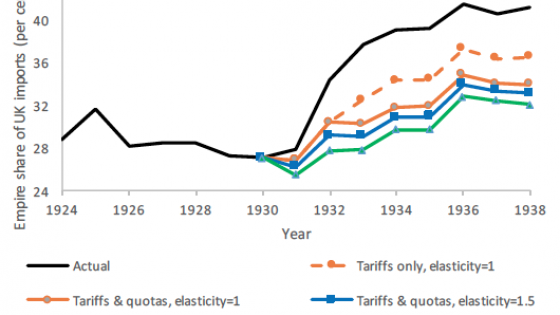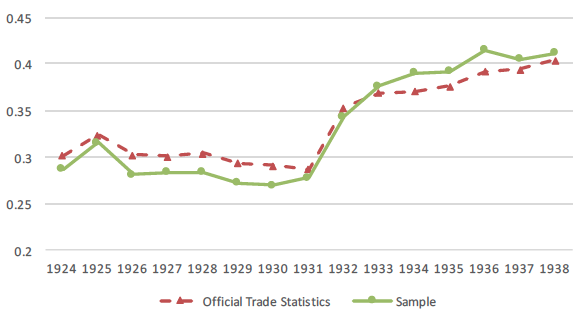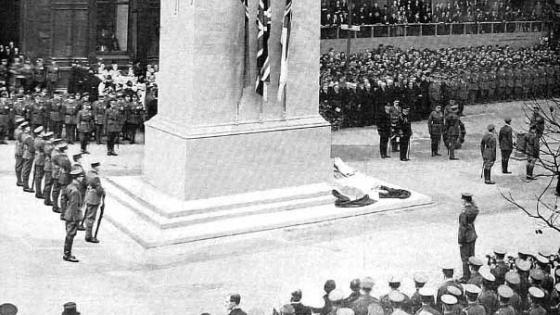In a recent survey paper, Goldberg and Pavcnik (2016) note that trade economists have moved away from studying the impact of trade policy. They suggest that this may partly reflect a belief that trade policy no longer matters, since by and large it has become so liberal. But they also note that studies estimating the impact of trade policies in the 1970s and 1980s, when these were not so uniformly liberal, suggest that they had no big effect then either. “Does trade policy matter?”, they ask. Did it ever matter?
With Brexit looming, and protectionist pressures mounting elsewhere in the developed world, this question is now taking on an obvious significance that it did not, perhaps, possess five years ago. And so it makes sense to look once more at the experience of the interwar period, when there were protectionist policies galore whose consequences can be studied.
Surprisingly, a lot of the existing quantitative literature on interwar trade has tended to conclude that, notwithstanding the ferocious reputation of the Smoot-Hawley tariff and interwar protectionism more generally, these policies did not have a major impact on either the total value or direction of trade. Perhaps it is not so surprising that protection has emerged as a relatively minor contributor to the world trade collapse of 1929-33 – world income and output fell by so much during this period that it can plausibly account for the majority of declining trade, leaving relatively little for rising trade barriers to explain. But the quantitative literature has also tended to downplay the impact of trade policy on a second striking, and dangerous, feature of world trade during this period – its decreasingly multilateral nature.
In the aftermath of WWII, policymakers looking back at the 1930s saw the shift away from multilateral trade as having been one of the most destructive features of the period. The increased tendency for trade to be organised around imperial or other trade blocs not only reflected the growing international tensions of the time, but arguably heightened them. Surely the policies of actual and aspirant empires had something to do with this shift in trade patterns? And so it is no surprise that the principle of non-discrimination, embodied in Article 1 of the GATT, became one of the central planks of post-war international trade law.
Figure 1 The British Empire’s share of UK imports, 1924–1938
Figure 1 shows the British Empire’s share of UK imports between 1924 and 1938: the increase after 1931 is striking. 1931 is the year in which Britain decisively broke with a long-standing tradition of free, or free-ish, trade. In November of that year the Abnormal Importations Act allowed the Board of Trade to impose tariffs of up to 100% ad valorem on manufactured goods from outside the Empire, and tariffs of 50% were immediately imposed on many of these. Another act soon followed, allowing for similar duties on non-Empire fruit, flowers, and vegetables. In February 1932 the Import Duties Act imposed a general 10% tariff on goods not already subject to duties, though some important primary imports were exempted. Finally, the Ottawa conference, which opened in July, saw a series of bilateral trade agreements being signed between the UK and the Dominions. In broad terms, Britain agreed to maintain or raise tariffs imposed on foreign imports under the terms of the 1932 Import Duties Act, and not to reduce the 10% tariff without the consent of the Dominions; to continue to exempt Empire products from these tariffs; and to introduce or enhance Imperial Preference on a wide range of agricultural commodities and raw materials of special interest to the Dominions, by raising duties or by protecting goods that had previously been duty free such as wheat (Drummond 1974: 266-268). Quotas were also introduced for several agricultural commodities, on the basis that policy needed to serve the interests of “the home producer first, Empire producers second, and foreign producers last” (Richardson 1936: 138). The Ottawa accords were thus explicitly discriminatory.
In an early econometric contribution, Eichengreen and Irwin (1995), using gravity methods and aggregate trade data, find that while pairs of countries that both belonged to the British Commonwealth traded more heavily with each other, this effect was already present in 1928, before Britain moved to protection, and before the Ottawa agreements set in place preferential trade policies within the Empire. They conclude that “the tendency toward regionalisation commonly ascribed to the formation of trade and currency blocs was already evident prior to the regional policy initiatives of the 1930s; to a considerable extent it is attributable to ongoing historical forces such as commercial and financial linkages between countries forged over many years.” Subsequent literature (Wolf and Ritschl 2011, Gowa and Hicks 2013) has largely reinforced this view, though Gowa and Hicks (2013) conclude that trade policy may have boosted trade between the UK and her Dominions (if not between the Dominions).
In a recent paper, we revisit the question of whether trade policy was responsible for the shift towards intra-imperial trade, but adopt an entirely different empirical approach in tackling the issue (de Bromhead et al. 2017). Rather than looking at the relationship between aggregate bilateral trade on the one hand, and country-pair block membership on the other, we study the actual (and discriminatory) trade policies pursued by one country – the UK – in great detail. Rather than looking at whether trade blocs existed or not, we look at what one country actually did, and at what the effects of its policies were. Furthermore, since so much interwar protectionism consisted of non-tariff barriers to trade, which affected imports of particular commodities only, and since tariff rates differ so greatly across commodities, we use disaggregated, country, and commodity-specific data on both trade and trade policies.
We construct a database of UK imports of 258 product categories (goods), from 42 countries, between 1924 and 1938. We also calculate commodity and country-specific tariff rates, and code a series of dummy variables indicating whether quantitative restrictions of various kinds applied to imports of particular commodities from particular countries in particular years. We then calculate elasticities of trade with respect to tariffs and quotas, including both country times commodity, and commodity times year, fixed effects in the econometric specification. These are elasticities of substitution between different (country-specific) varieties of particular imported goods (e.g. Canadian versus Argentinian wheat).
Armed with these elasticities, we then calculate a variety of counterfactual ‘free trade’ or ‘constant policy’ equilibria for individual years in the 1930s, which can be compared with the actual trade data. We do so using three values of the higher-level elasticity of substitution γ between different goods (e.g. wheat and cars), to see to what extent this elasticity matters for our results. The model we use to calculate these counterfactual equilibria is straightforward – on the demand side we assume nested utility functions as in Broda and Weinstein (2006), while on the supply side a single production sector transforms the sole factor of production into domestically consumed output and exports via a constant elasticity of transformation production function. For each year, we solve the model using the actual tariffs and quotas in place during that year, and then compute equilibria for various counterfactual sets of tariffs and quotas. In this manner we can obtain estimates of the impact of protection on the share of the British Empire in the UK’s imports.
Figure 2 The British Empire’s share of UK imports, counterfactual scenarios 1924–1938
What if tariffs had not been increased after 1930, and quotas had not been introduced either? Figure 2 shows what the share of Empire would have been under this counterfactual scenario. In order to distinguish the separate impacts of tariffs and quotas, it also plots the impact of freezing tariff policies only. As can be seen, both tariffs and quotas increased the Empire’s share of British trade. If trade policy had remained frozen at its 1930 level, the Empire would have accounted for between 30% (γ = 2) and 32% (γ = 1) of UK imports in 1935, whereas in fact it accounted for 39%. Assuming γ = 1, trade policy accounted for 70% of the shift between 1930 and 1933, and 60% of the shift between 1930 and either 1934 or 1935. These are big effects.
Methodologically, our work suggests that there are substantial advantages to using disaggregated data, and to looking at what trade blocs do, as opposed to using aggregate data and simply looking at whether blocs exist or not. Historically, the paper suggests that interwar trade policy mattered more for trade patterns than the cliometric literature has suggested. It certainly mattered a lot in the British case; whether what was true for the UK was also true elsewhere is a question that we hope to address in future research.
References
Broda, C and D E Weinstein (2006) “Globalization and the gains from variety”, The Quarterly Journal of Economics, 121: 541-585.
de Bromhead, A, A Fernihough, M Lampe and K H O'Rourke (2017) “When Britain turned inward: Protection and the shift towards Empire in interwar Britain”, CEPR, Discussion paper 11835.
Drummond, I M (1974) Imperial economic policy, 1917-1939 : Studies in expansion and protection, Toronto: University of Toronto Press.
Eichengreen, B and D A Irwin (1995) “Trade blocs, currency blocs and the reorientation of world trade in the 1930s”, Journal of International Economics, 38: 1-24.
Goldberg, P K and N Pavcnik (2016) “The effects of trade policy”, NBER, Working paper no 21957.
Gowa, J and R Hicks (2013) “Politics, institutions, and trade: Lessons of the interwar era”, International Organization, 67: 439-467.
Richardson, J H (1936) British economic foreign policy, London: G Allen & Unwin.
Wolf, N and A O Ritschl (2011) “Endogeneity of currency areas and trade blocs: Evidence from a natural experiment”, Kyklos, 64: 291-312.








